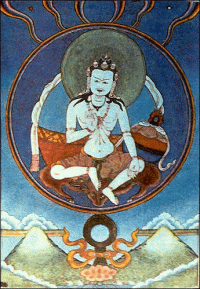প্রহেবজ্র

প্রহেবজ্র বা প্রমোদবজ্র[১] বা দ্গা'-রাব-র্দো-র্জে (তিব্বতি: དགའ་རབ་རྡོ་རྗེ་, ওয়াইলি: dga’ rab rdo rje)[২] বৌদ্ধ ধর্মের অতিযোগ তত্ত্বের প্রথম শিক্ষক ছিলেন।
নাম
[সম্পাদনা]ডেভিড ফ্রান্সিস জার্মানো র্ন্যিং মা ধর্মসম্প্রাদায়ের অতিযোগযানের উপদেশবর্গ তত্ত্বের সতেরো তন্ত্রের একটি তন্ত্র স্গ্রা-থাল-গ্যুর তন্ত্রে বজ্রপ্রহে নামটি পান।[৩] অপরদিকে জন রেনল্ডস বার-দো-থোস-গ্রোল গ্রন্থের রিগ-পা-ঙ্গো-স্প্রোদ-গ্চার-ম্থোং-রাং-গ্রোল নামক একটি বিভাগ বিশ্লেষণ ও ইংরেজিতে অনুবাদের সময় প্রহেবজ্র নামের উল্লেখ করেন।[৪] কিন্তু তিব্বতী ভাষায় দ্গা'-রাব-র্দো-র্জে নাম পাওয়া গেলেও কোন সংস্কৃত গ্রন্থে প্রহেবজ্র নামটি পাওয়া যায় নি।
জন্ম
[সম্পাদনা]প্রহেবজ্রের জন্ম নিয়ে দ্বিমত রয়েছে। প্রহেবজ্রের জন্ম ওড্ডিয়ানের রাজা উপরাজার কন্যা সুধর্মের গর্ভে হয় বলে অনুমান করা হয়।[৫]:১২৫ এই বিষয়ে কিছু কিংবদন্তিও প্রচলিত আছে।[n ১] অপরদিকে কুত্রা নামক হ্রদের তীরে পারনি নামক এক মহিলার গর্ভে প্রহেবজ্রের জন্ম হয় বলেও মতবাদ রয়েছে।[৫]:১৯৯
শিক্ষা
[সম্পাদনা]প্রহেবজ্র বজ্রসত্ত্ব ও বজ্রপাণির নিকট হতে অতিযোগ তত্ত্ব শিক্ষালাভ করেন। তিনি মহাসিদ্ধ কাকুরাজার নিকট হতে গুহ্যগর্ভতন্ত্র নামক মহাযোগ তন্ত্রের শিক্ষালাভ করেন।[২] প্রহেবজ্র মঞ্জুশ্রীমিত্রকে অতিযোগ তত্ত্বের শিক্ষা দান করেন।
অন্তিম শিক্ষা
[সম্পাদনা]মৃত্যুকালে প্রহেবজ্র মঞ্জুশ্রীমিত্রকে অতিযোগ তত্ত্বের সাররূপে তিনটি শিক্ষা দান করেন। এই তিনটি শিক্ষাকে তিব্বতী বৌদ্ধধর্মে ত্শিগ-গ্সুম-গ্নাদ-ব্র্দেগ (ওয়াইলি: tshig gSum gNad brDeg) বলা হয়ে থাকে।[১] এই তিনটি শিক্ষা হল-
- ঙ্গো-রাং-থোগ-তু-স্প্রাদ (ওয়াইলি: ngo rang thog tu sPrad)[১] বা প্রত্যক্ষ পরিচয়
- থাগ-গ্চিগ-থোগ-দুগ-চাদ (ওয়াইলি: thag gCig thog dug Cad)[১] বা সন্দেহহীনতা
- গ্দেংস-গ্রোল-থোগ-দু-'চা (ওয়াইলি: gDengs grol thog du ’cha’)[১] বা অদ্বৈতভাব
পাদটীকা
[সম্পাদনা]- ↑ The Lord of Secrets (gSang-ba'i-bdag-po) instructed the Holders of Wisdom (Rig-'dsin) in Dhanakośa in Uḍḍiyāna the contemporary Swat valley. There was a large temple, called bDe-byed-brtsegs-pa; it was surrounded by 1608 smaller chapels. King Uparāja, and Queen sNang-ba-gsal-ba'i-od-ldan-ma resided there. They had a daughter called Sudharmā; she took the novice vows, and soon afterwards the full monastic vows. Sudharmā, together with her maidens, stayed on an island and meditated about the Yoga Tantra (rnal-'byor-gyi rgyud). One night the Bhikṣuṇī Sudharmā dreamed that a white man had come, who was utterly pure and beautiful. He held a crystal vessel in his hand which had the letters oṃ ā hūṃ svāhā engraved upon it. Three times he set the vessel upon the crown of her head, and light then shone from it. While this happened, she beheld the threefold world perfectly and clearly. Not long after this dream the Bhikṣuṇī gave birth to a true son of the gods.[৬]
তথ্যসূত্র
[সম্পাদনা]- ↑ ক খ গ ঘ ঙ Déchen, Khandro & Ngak’chang Rinpoche (undated). "Dzogchen transmission of the non-dual state." Aro Encyclopædia. Source: [১] (accessed: February 1, 2008)
- ↑ ক খ Dharma Fellowship (2005). Biographies: Pramodavajra, Regent of the Divine. Source: [২] ওয়েব্যাক মেশিনে আর্কাইভকৃত ৪ ফেব্রুয়ারি ২০২০ তারিখে (accessed: November 15, 2007)
- ↑ Germano, David Francis (1992). "Poetic thought, the intelligent Universe, and the mystery of self: The Tantric synthesis of rDzogs Chen in fourteenth century Tibet." The University of Wisconsin, Madison. Doctoral thesis. Source: [৩] ওয়েব্যাক মেশিনে আর্কাইভকৃত ১ মার্চ ২০১২ তারিখে (accessed: Friday December 18, 2009)
- ↑ Reynolds, John Myrdhin (translator, 1989, 2000 revised). Self-Liberation Through Seeing with Naked Awareness. [rig pa ngo sprod gcer mthong rang grol] Ithaca, NY: Snow Lion.
- ↑ ক খ Erik Pema Kunsang (translator) : Wellsprings of the Great Perfection. Rangjung Yeshe Publications, Hong Kong, 2006
- ↑ Dargyay, Eva M. (author) & Wayman, Alex (editor)(1977, 1998). The Rise of Esoteric Buddhism in Tibet. Second revised edition, reprint.Delhi, India: Motilal Banarsidass Publishers Pvt Ltd. Buddhist Tradition Series Vol.32. আইএসবিএন ৮১-২০৮-১৫৭৯-৩ (paper), p.19
আরো পড়ুন
[সম্পাদনা]- John Myrdhin Reynolds 'The Golden Letters' ; Ithaca NY 1996; Snow Lion; আইএসবিএন ৯৭৮-১-৫৫৯৩৯-০৫০-৭